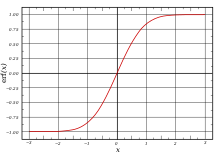
Back Sigmoïde-funksie Afrikaans دالة سينية Arabic Siqmoid funksiyası Azerbaijani Funció sigmoide Catalan Sigmoida Czech Sigmoidfunktion German Σιγμοειδής συνάρτηση Greek Función sigmoide Spanish Sigmoidfunktsioonid Estonian Funtzio sigmoide Basque


A sigmoid function is any mathematical function whose graph has a characteristic S-shaped or sigmoid curve.
A common example of a sigmoid function is the logistic function, which is defined by the formula:[1]
Other sigmoid functions are given in the Examples section. In some fields, most notably in the context of artificial neural networks, the term "sigmoid function" is used as a synonym for "logistic function".
Special cases of the sigmoid function include the Gompertz curve (used in modeling systems that saturate at large values of x) and the ogee curve (used in the spillway of some dams). Sigmoid functions have domain of all real numbers, with return (response) value commonly monotonically increasing but could be decreasing. Sigmoid functions most often show a return value (y axis) in the range 0 to 1. Another commonly used range is from −1 to 1.
A wide variety of sigmoid functions including the logistic and hyperbolic tangent functions have been used as the activation function of artificial neurons. Sigmoid curves are also common in statistics as cumulative distribution functions (which go from 0 to 1), such as the integrals of the logistic density, the normal density, and Student's t probability density functions. The logistic sigmoid function is invertible, and its inverse is the logit function.
